杨丽霞Unit 6 When was it invented教学设计与反思
- 格式:doc
- 大小:25.50 KB
- 文档页数:2
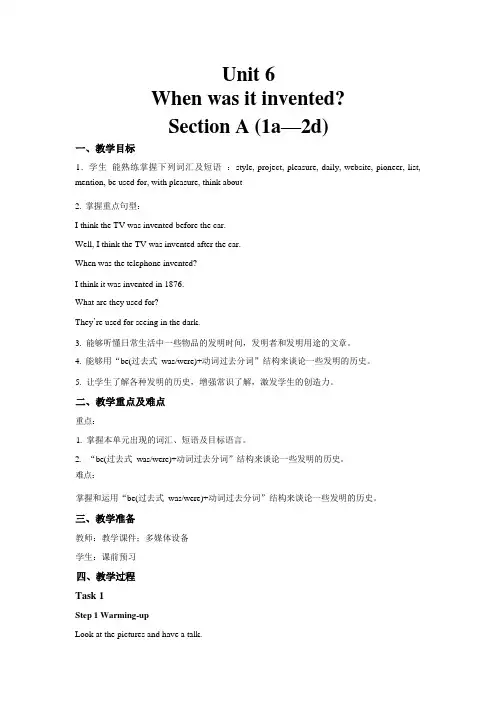
Unit6When was it invented?Section A(1a—2d)1. 学生能熟练掌握下列词汇及短语:style, project, pleasure, daily, website, pioneer, list, mention, be used for, with pleasure, think about2. 掌握重点句型:I think the TV was invented before the car.Well, I think the TV was invented after the car.When was the telephone invented?I think it was invented in 1876.What are they used for?They’re used for seeing in the dark.3. 能够听懂日常生活中一些物品的发明时间,发明者和发明用途的文章。
4. 能够用“be(过去式was/were)+动词过去分词”结构来谈论一些发明的历史。
5. 让学生了解各种发明的历史,增强常识了解,激发学生的创造力。
重点:1. 掌握本单元出现的词汇、短语及目标语言。
2. “be(过去式was/were)+动词过去分词”结构来谈论一些发明的历史。
难点:掌握和运用“be(过去式was/were)+动词过去分词”结构来谈论一些发明的历史。
教师:教学课件;多媒体设备学生:课前预习Task1Step1Warming-upLook at the pictures and have a talk.T: Which one do you think is the most helpful invention in our daily life?S:…【设计意图】通过图片帮助学生理解invention 的含义,引出更多发明名称,为下一步讨论发明作好词汇准备。
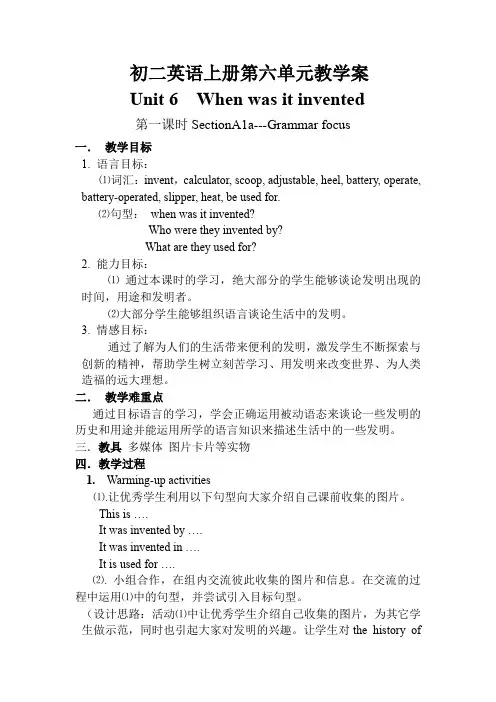
初二英语上册第六单元教学案Unit 6 When was it invented第一课时SectionA1a---Grammar focus一.教学目标1.语言目标:⑴词汇:invent,calculator, scoop, adjustable, heel, battery, operate, battery-operated, slipper, heat, be used for.⑵句型:when was it invented?Who were they invented by?What are they used for?2.能力目标:⑴通过本课时的学习,绝大部分的学生能够谈论发明出现的时间,用途和发明者。
⑵大部分学生能够组织语言谈论生活中的发明。
3.情感目标:通过了解为人们的生活带来便利的发明,激发学生不断探索与创新的精神,帮助学生树立刻苦学习、用发明来改变世界、为人类造福的远大理想。
二.教学难重点通过目标语言的学习,学会正确运用被动语态来谈论一些发明的历史和用途并能运用所学的语言知识来描述生活中的一些发明。
三.教具多媒体图片卡片等实物四.教学过程1. Warming-up activities⑴.让优秀学生利用以下句型向大家介绍自己课前收集的图片。
This is ….It was invented by ….It was invented in ….It is used for ….⑵. 小组合作,在组内交流彼此收集的图片和信息。
在交流的过程中运用⑴中的句型,并尝试引入目标句型。
(设计思路:活动⑴中让优秀学生介绍自己收集的图片,为其它学生做示范,同时也引起大家对发明的兴趣。
让学生对the history ofinventions介绍有初步的认识和把握。
通过活动⑵让所有学生都能获得说的机会,进一步熟悉与the history of inventions的相关内容。
为下一步目标句型的出现做好热身准备。
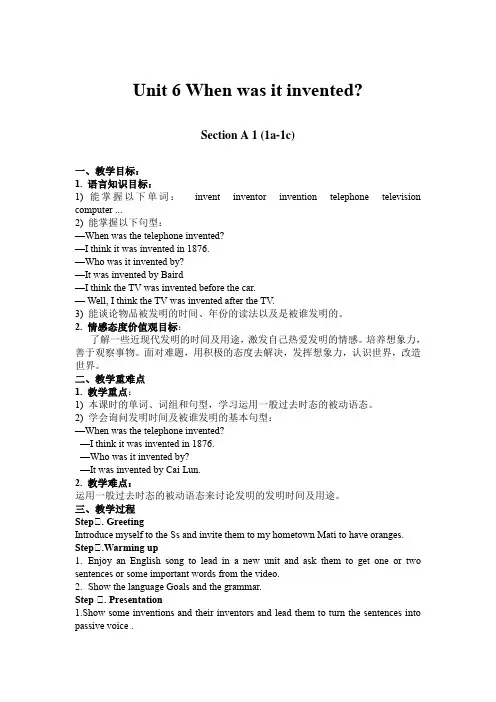
Unit 6 When was it invented?Section A 1 (1a-1c)一、教学目标:1. 语言知识目标:1) 能掌握以下单词:invent inventor invention telephone television computer ...2) 能掌握以下句型:—When was the telephone invented?—I think it was invented in 1876.—Who was it invented by?—It was invented by Baird—I think the TV was invented before the car.— Well, I think the TV was invented after the TV.3) 能谈论物品被发明的时间、年份的读法以及是被谁发明的。
2. 情感态度价值观目标:了解一些近现代发明的时间及用途,激发自己热爱发明的情感。
培养想象力,善于观察事物。
面对难题,用积极的态度去解决,发挥想象力,认识世界,改造世界。
二、教学重难点1. 教学重点:1) 本课时的单词、词组和句型,学习运用一般过去时态的被动语态。
2) 学会询问发明时间及被谁发明的基本句型:—When was the telephone invented?—I think it was invented in 1876.—Who was it invented by?—It was invented by Cai Lun.2. 教学难点:运用一般过去时态的被动语态来讨论发明的发明时间及用途。
三、教学过程StepⅠ. GreetingIntroduce myself to the Ss and invite them to my hometown Mati to have oranges. StepⅠ.Warming up1.Enjoy an English song to lead in a new unit and ask them to get one or two sentences or some important words from the video.2.Show the language Goals and the grammar.Step Ⅰ. Presentation1.Show some inventions and their inventors and lead them to turn the sentences into passive voice .---Karl Benz invented the first car .---The first car was invented by Karl Benz .---Bell invented the first telephone .---The first telephone was invented by Bell.2. Talking1. Look at the pictures in 1a. Discuss with your group, in what order do you think they were invented? Try to number them [1-4]. (1a)2. Lead the Ss to talk about these inventions3. Play a game :show two inventions first and lead them to talk about them like this: A: I think the TV was invented before the car.B: Well, I think the TV was invented after the car.After it I’ll give the right answer on the screen ,Then talk about other inventions.At last ,give the right order on the screen.StepⅠ. Listening (1b)1.show the rules of reading years and lead them to read the years on the sreen.Practice again and again.2 T: Tell Ss to look at the pictures and years on the left. Then ask the Ss to read them together .3. . Play the recording for the Ss to listen. to the conversation and try to match the invention with the proper year.4. Play the recording again. And get the Ss to fill in the chart on their paper .Then play again to check answers.And last , get the Ss read the conversation together.StepⅠ. Pair work (1c)1. Ss try to read the model conversation.2. Student A, ask Student B when the things in the picture in 1b were invented and who was it invented by.Student B answer the questions. Then change roles and practice again.3. Let some pairs ask and answer in pairs.e.g. A: When was the television invented?B: I think it was invented in 1927.A: Who was it invented by?B: It was invented by Baird.4.Ask a Ss to read a conversation and ask other Ss to guess the invention. Then Show the four great Chinese inventions and lead the Ss to talk about it.5.give a saying :Genius is one percent inspiration and ninety-nine percent perspiration. (天才是百分之一的灵感加上百分之九十九的汗水) and motivate the Ss to study hard and try to be an inventor.Step VI SummaryRead the conversations in this page.And get them to review the grammar and important sentences.Step VII homeworkSearch information of an invention on the internet, write an article about it ,try your best to describe it .Next class ,share your ideas to other Ss.Step VIII ExerciseBlackboard design:Unit 6 When was it invented?Section A 1 (1a-1c)A: Who was it invented by?B: It was invented by...A: When was it invented ?B: It was invented in。
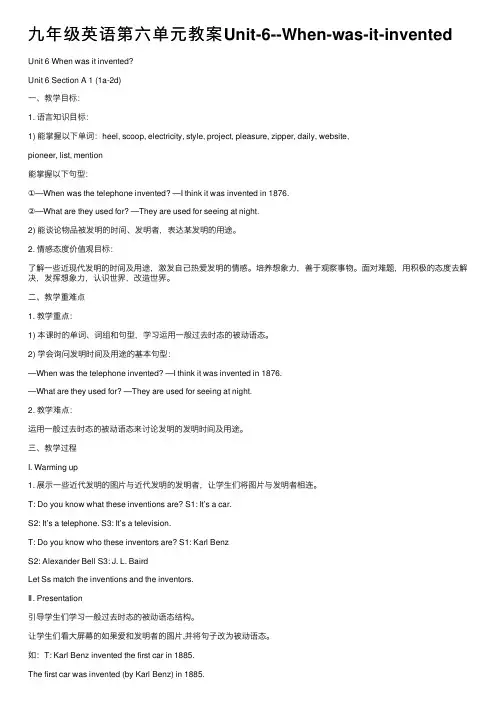
九年级英语第六单元教案Unit-6--When-was-it-invented Unit 6 When was it invented?Unit 6 Section A 1 (1a-2d)⼀、教学⽬标:1. 语⾔知识⽬标:1) 能掌握以下单词:heel, scoop, electricity, style, project, pleasure, zipper, daily, website,pioneer, list, mention能掌握以下句型:①—When was the telephone invented? —I think it was invented in 1876.②—What are they used for? —They are used for seeing at night.2) 能谈论物品被发明的时间、发明者,表达某发明的⽤途。
2. 情感态度价值观⽬标:了解⼀些近现代发明的时间及⽤途,激发⾃⼰热爱发明的情感。
培养想象⼒,善于观察事物。
⾯对难题,⽤积极的态度去解决,发挥想象⼒,认识世界,改造世界。
⼆、教学重难点1. 教学重点:1) 本课时的单词、词组和句型,学习运⽤⼀般过去时态的被动语态。
2) 学会询问发明时间及⽤途的基本句型:—When was the telephone invented? —I think it was invented in 1876.—What are they used for? —They are used for seeing at night.2. 教学难点:运⽤⼀般过去时态的被动语态来讨论发明的发明时间及⽤途。
三、教学过程I. Warming up1. 展⽰⼀些近代发明的图⽚与近代发明的发明者,让学⽣们将图⽚与发明者相连。
T: Do you know what these inventions are? S1: It’s a car.S2: It’s a telephone. S3: It’s a television.T: Do you know who these inventors are? S1: Karl BenzS2: Alexander Bell S3: J. L. BairdLet Ss match the inventions and the inventors.Ⅱ. Presentation引导学⽣们学习⼀般过去时态的被动语态结构。
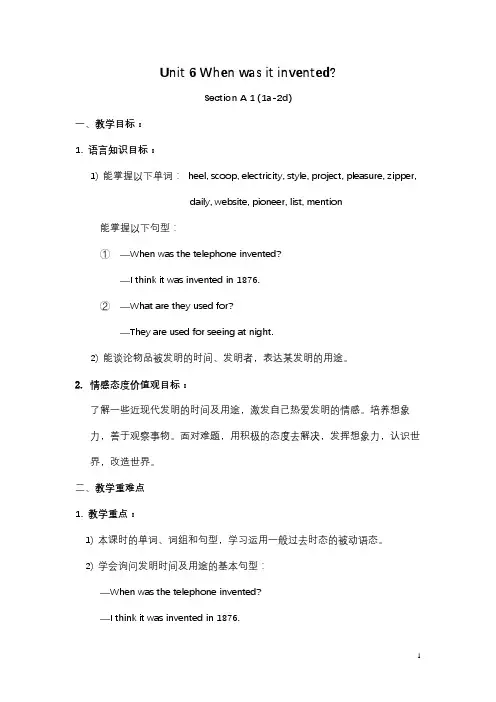
1 Unit 6 When was it invented? Section A 1 (1a-2d) 一、教学目标: 1. 语言知识目标: 1) 能掌握以下单词: heel, scoop, electricity, style, project, pleasure, zipper, daily, website, pioneer, list, mention 能掌握以下句型: ① —When was the telephone invented? —I think it was invented in 1876. ② —What are they used for? —They are used for seeing at night. 2) 能谈论物品被发明的时间、发明者,表达某发明的用途。 2. 情感态度价值观目标: 了解一些近现代发明的时间及用途,激发自己热爱发明的情感。培养想象力,善于观察事物。面对难题,用积极的态度去解决,发挥想象力,认识世界,改造世界。 二、教学重难点 1. 教学重点: 1) 本课时的单词、词组和句型,学习运用一般过去时态的被动语态。 2) 学会询问发明时间及用途的基本句型: —When was the telephone invented? —I think it was invented in 1876. 2
—What are they used for? —They are used for seeing at night. 2. 教学难点: 运用一般过去时态的被动语态来讨论发明的发明时间及用途。 三、教学过程 I. Warming up 1. 展示一些近代发明的图片与近代发明的发明者,让学生们将图片与发明者相连。 T: Do you know what these inventions are? S1: It’s a car. S2: It’s a telephone. S3: It’s a television. T: Do you know who these inventors are? S1: Karl Benz S2: Alexander Bell S3: J. L. Baird Let Ss match the inventions and the inventors. Ⅱ. Presentation 引导学生们学习一般过去时态的被动语态结构。 让学生们看大屏幕的如果爱和发明者的图片,并将句子改为被动语态。 如: T: Karl Benz invented the first car in 1885. 3
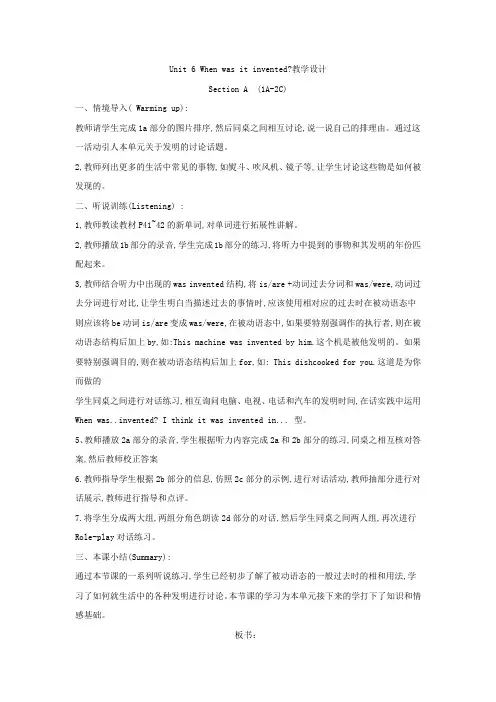
Unit 6 When was it invented?教学设计Section A (1A-2C)一、情境导入( Warming up):教师请学生完成1a部分的图片排序,然后同桌之间相互讨论,说一说自己的排理由。
通过这一活动引人本单元关于发明的讨论话题。
2,教师列出更多的生活中常见的事物,如熨斗、吹风机、镜子等,让学生讨论这些物是如何被发现的。
二、听说训练(Listening) :1,教师教读教材P41~42的新单词,对单词进行拓展性讲解。
2,教师播放1b部分的录音,学生完成1b部分的练习,将听力中提到的事物和其发明的年份匹配起来。
3,教师结合听力中出现的was invented结构,将is/are +动词过去分词和was/were,动词过去分词进行对比,让学生明白当描述过去的事情时,应该使用相对应的过去时在被动语态中则应该将be动词is/are变成was/were,在被动语态中,如果要特别强调作的执行者,则在被动语态结构后加上by,如:This machine was invented by him.这个机是被他发明的。
如果要特别强调目的,则在被动语态结构后加上for,如: This dishcooked for you.这道是为你而做的学生同桌之间进行对话练习,相互询问电脑、电视、电话和汽车的发明时间,在话实践中运用When was..invented? I think it was invented in... 型。
5、教师播放2a部分的录音,学生根据听力内容完成2a和2b部分的练习,同桌之相互核对答案,然后教师校正答案6.教师指导学生根据2b部分的信息,仿照2c部分的示例,进行对话活动,教师抽部分进行对话展示,教师进行指导和点评。
7.将学生分成两大组,两组分角色朗读2d部分的对话,然后学生同桌之间两人组,再次进行Role-play对话练习。
三、本课小结(Summary):通过本节课的一系列听说练习,学生已经初步了解了被动语态的一般过去时的相和用法,学习了如何就生活中的各种发明进行讨论。
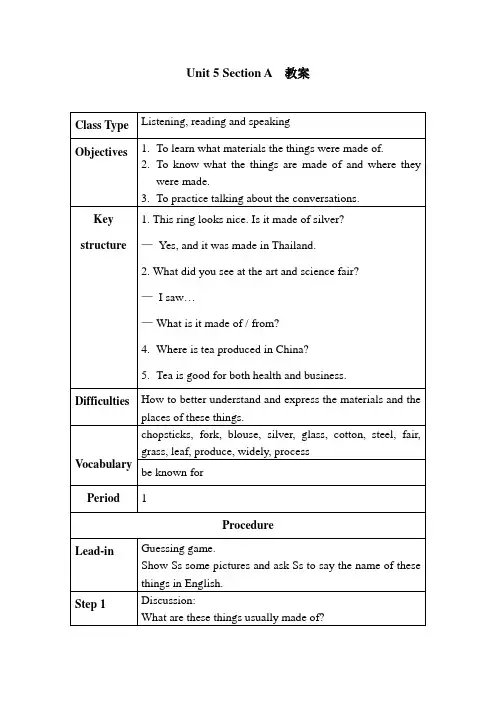
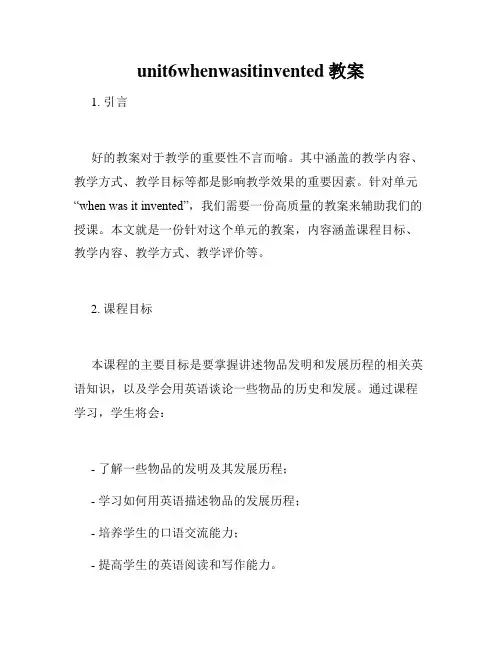
unit6whenwasitinvented教案1. 引言好的教案对于教学的重要性不言而喻。
其中涵盖的教学内容、教学方式、教学目标等都是影响教学效果的重要因素。
针对单元“when was it invented”,我们需要一份高质量的教案来辅助我们的授课。
本文就是一份针对这个单元的教案,内容涵盖课程目标、教学内容、教学方式、教学评价等。
2. 课程目标本课程的主要目标是要掌握讲述物品发明和发展历程的相关英语知识,以及学会用英语谈论一些物品的历史和发展。
通过课程学习,学生将会:- 了解一些物品的发明及其发展历程;- 学习如何用英语描述物品的发展历程;- 培养学生的口语交流能力;- 提高学生的英语阅读和写作能力。
3. 教学内容(1) 课文教学:通过课文学习,了解一些有影响力的物品发明历程。
(2) 词汇学习:学习本单元出现的一些常用词汇,如invention (发明)、device(装置)、telephone(电话)等。
(3) 语法学习:了解过去分词的用法和应用场景。
(4) 口语表达:通过各种练习,提高学生口语表达和交际能力。
(5) 写作训练:通过写作训练,提高学生英语写作能力。
4. 教学方式本课程主要采用任务型教学方式,通过完成一系列的任务来巩固学习内容,确保学生能够真正掌握所学知识。
同时,也会注重听说能力的训练,加强学生的口语表达能力。
具体的教学方式包括以下几个环节:(1) 师生互动环节:老师可以通过提问学生的方式来了解学生已有的知识水平,并及时调整课程内容。
(2) 录音听力环节:利用录音机等设备来听课文录音以及一些听力练习。
(3) 词汇学习环节:教师让学生背诵一些单词、短语,并将其出现在对话中密集讲解。
(4) 任务型学习环节:选取一些任务性课程活动,包括对话、问答、小组活动等,通过已学知识完成任务,以此来巩固所学知识。
(5) 写作练习环节:让学生写一篇介绍物品发展历程的文章,以此来提高学生英语写作能力。
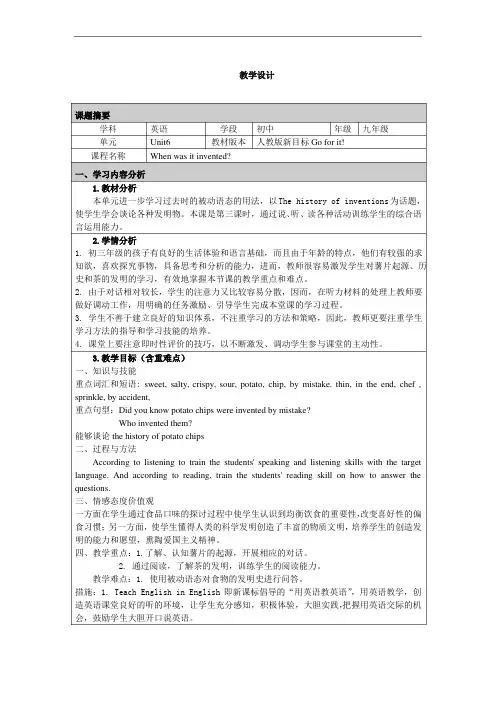
教学设计课题摘要学科单元课程名称一、学习内容分析1.教材分析本单元进一步学习过去时的被动语态的用法,以The history of inventions 为话题,使学生学会谈论各种发明物。
本课是第三课时,通过说、听、读各种活动训练学生的综合语言运用能力。
2.学情分析1.初三年级的孩子有良好的生活体验和语言基础,而且由于年龄的特点,他们有较强的求知欲,喜欢探究事物,具备思考和分析的能力,进而,教师很容易激发学生对薯片起源、历史和茶的发明的学习,有效地掌握本节课的教学重点和难点。
2.由于对话相对较长,学生的注意力又比较容易分散,因而,在听力材料的处理上教师要做好调动工作,用明确的任务激励、引导学生完成本堂课的学习过程。
3.学生不善于建立良好的知识体系,不注重学习的方法和策略,因此,教师更要注重学生学习方法的指导和学习技能的培养。
4.课堂上要注意即时性评价的技巧,以不断激发、调动学生参与课堂的主动性。
3.教学目标(含重难点)一、知识与技能重点词汇和短语:sweet,salty,crispy,sour,potato,chip,by mistake.thin,in the end,chef ,sprinkle, by accident,重点句型:Did you know potato chips were invented by mistake?Who invented them?能够谈论the history of potato chips二、过程与方法According to listening to train the students'speaking and listening skills with the target language.And according to reading,train the students'reading skill on how to answer the questions.三、情感态度价值观一方面在学生通过食品口味的探讨过程中使学生认识到均衡饮食的重要性,改变喜好性的偏食习惯;另一方面,使学生懂得人类的科学发明创造了丰富的物质文明,培养学生的创造发明的能力和愿望,熏陶爱国主义精神。
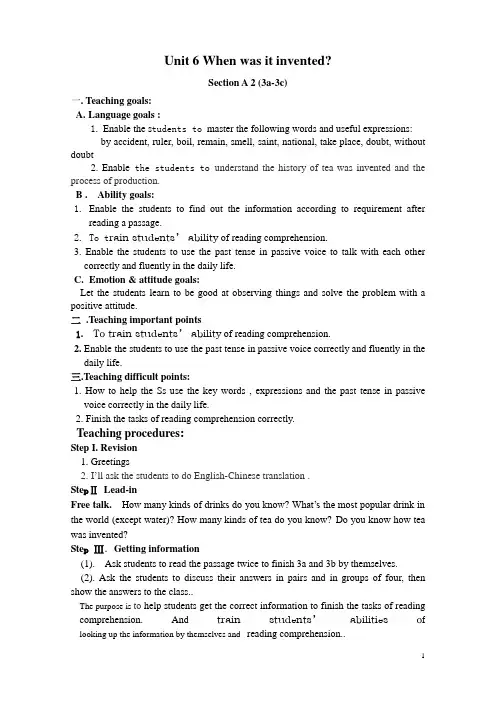
Unit 6 When was it invented?Section A 2 (3a-3c)一. Teaching goals:A. Language goals :1. Enable the s tudents to master the following words and useful expressions:by accident, ruler, boil, remain, smell, saint, national, take place, doubt, without doubt2. Enable the students to understand the history of tea was invented and the process of production.B . Ability goals:1. Enable the students to find out the information according to requirement afterreading a passage.2. To t rain students’ ability of reading comprehension.3. Enable the students to use the past tense in passive voice to talk with each othercorrectly and fluently in the daily life.C. Emotion & attitude goals:Let the students learn to be good at observing things and solve the problem with a positive attitude.二.Teaching important points1. To tr ain students’ ability of reading comprehension.2. Enable the students to use the past tense in passive voice correctly and fluently in thedaily life.三.Teaching difficult points:1. How to help the Ss use the key words , expressions and the past tense in passivevoice correctly in the daily life.2. Finish the tasks of reading comprehension correctly.Teaching procedures:Step I. Revision1. Greetings2. I’ll ask the students to do English-Chinese translation .Ste pⅡLead-inFree talk. How many kinds of drinks do you know? What’s the most popular drink in the world (except water)? How many kinds of tea do you know?Do you know how tea was invented?Ste p Ⅲ.Getting information(1). Ask students to read the passage twice to finish 3a and 3b by themselves.(2). Ask the students to discuss their answers in pairs and in groups of four, then show the answers to the class..The purpose is to help students get the correct information to finish the tasks of reading comprehension. And train students’ abilit ies of looking up the information by themselves and reading comprehension..Ste p Ⅳ.Learning the text languageLet the students read the passage and underline the following phases and sentences in their book and take notes on their own. . Next, check the answers in pairs . Then read them several times.The purpose is to help students learn and master the key phases and understand the difficult sentences better.Step V. Using the text languageAsk the students to finish 3c and translate the following sentences be themselves. Then , discuss their answers with parters, next in groups. Finally, ask some students to show their answers to the class.The purpose is to train students’ abilit ies of do-it-yourself and using the past tense in passive voice correctly.。
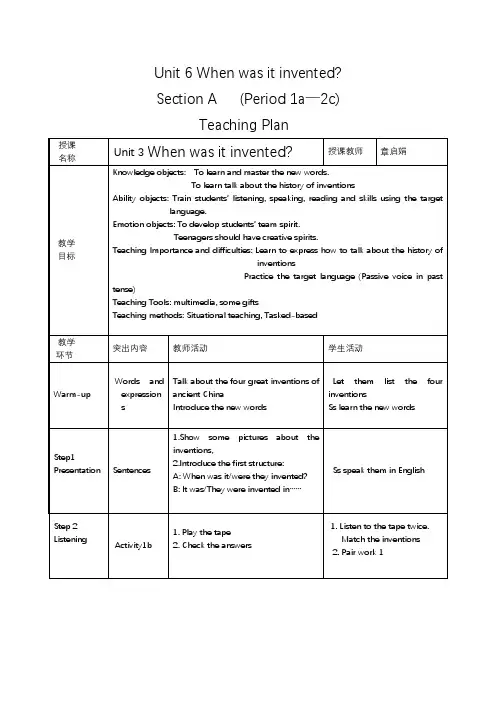
九年级英语Unit 6 When was it invented? Section A(1a-2c) 教学反思
英语对于现在的学生来说,是一门比较难学的学科。许多学生都说英语真困难,不愿意学
习它。从而导致他们学习的不太理想。最近,有件事情使我感触太深了。认识到了学生不是
学不好,而是存在着有他们不愿意学习、学习积极性不高等的因素.
由于学习谈论发明时间,发明人和用途等,我觉得直观教学比较适合,所以我就把这节课
制作成了课件。
Teaching contents: When was it / were they invented?
What is it / are they used for?
Teaching aims: Let students talk about the dates of inventions , inventors and functions .
Teaching tools: tape recorder and powerpoint
我首先通过
通过图片引出“What was... invented? ”句型。然后通过答语“I think it was invented in 1876.”
引出年代,让学生对数字进行复习巩固。接着让学生进行对话练习。这样顺其自然地导入能
调动学生的积极性,为后面的课堂话题真正展开作好铺垫。
3.展示目标,让学生了解本节课学掌握的主要内容。
4.看图片排序,完成1a.根据图片引导学生重点练习before, after。
5.听力练习:(1)听录音,完成1b.学生听前看图片,看数字。注意听关键字。
(2)利用图片,学习heel, style, scoop等生词。
(3)听录音,完成2a, 为你听到的发明物排序。教师指出注意关键字。
(4)再听一遍录音,完成2b表格,注意关键字。
(5)阅读课本139页的听力材料,完成短文。
6.当堂检测:检测反馈本节学生掌握的情况。
7.总结:总结本节课所学内容。
8.作业:(1)根据2b编一个小对话。(2)完成课时分层训练二十一.
教学反思:
本堂课的收获和优点:
1.本节课调动了学生的学习积极性。
2.时间调控较好。
本堂课的不足:1.老师讲的过多,学生练习的少。2.声音过大,老师太累。3.导入部分
时间过长。4.本节课的设计是教师为学生做的太多,考虑的太多,因放开手让学生多思考。
5.听力部分,不应做过多铺垫,这样听起来反而没有挑战。让学生体验失败,反复尝试。6.
生生互动不多,今后应该再多设置一些师生互动,生生互动的活动。7.本节英语课上我的讲
解基本上还拘泥于教材的信息,而开放型的、能激发学生想象力与创造力和发散学生思维的
课堂比例还较小。
通过这次听评课活动,我的收获很大,在今后的英语教学中我要以学生为主体,教师为引导。
多鼓励差生开口说英语,并能及时地表扬他们。教师要有课堂效益意识。教学效益首先体现
在课堂教学信息量、教学活动的广度和密度以及媒体的使用上。有效的媒体手段有助于课堂
容量、密度和速度的提高。尤其是在英语课堂上适当地使用多媒体手段,不但可以活跃课堂,
更能提高学生的参与面,短、频、快的大容量课堂节奏能有效的吸引并集中学生的学习注意,
从而最终提高学习的听课效益;其次,课堂效益意识还体现在教学的设计中要充分为学而教,
以学生如何有效获取知识,提高能力的标准来设计教学。课堂设计要有助于学生在课堂上积
极参与,有助于他们有效内化知识与信息,复习过程中要重视学习方法的指导,在教学中恰
当地渗透中考的信息,拓宽教学内容。
在今后的教学中,我要不断的更改教学方式,要从根本培养起学生学习的兴趣。只有兴趣
才是最好的老师。好的先生不是教书,不是教学生,而是教学生学。